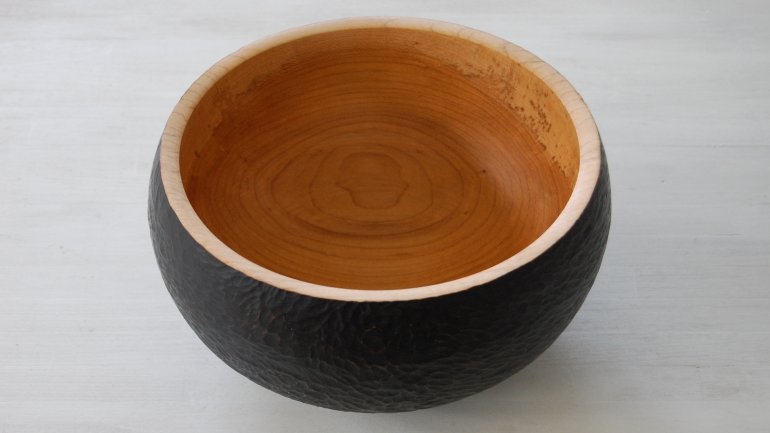On View at ACC: Nathan White
Stop by the American Craft Council to view new work on display by Minneapolis woodworker Nathan Patrick White.
White has done all sorts of work related to wood, from carving spoons to apprenticing with Maine craftspeople to learn how to build and restore wooden boats. He's currently making turned-wood vessels, carved spoons, and furniture. He also recently received a Folk and Traditional Art Grant from the Minnesota State Arts Board and has been focusing on historic Scandinavian vessels.
Now through the end of October, White's work will be hanging in our office. We hope you'll stop in to see it. Meanwhile, we asked White a few questions to learn more about him, his work, and his process.
What do you make? What do you want to make?
I make things out of wood. Lately I've been making a lot of turned bowls and furniture. I really like to make things that people want to touch, pick up, and examine. I've been making a lot of functional things lately, but would like to make more things in the realm of art – more sculpture and ambiguous things whose function isn't very obvious or the same to everyone.
Who and what inspires you?
I really enjoy watching an expert at work – any master doing any thing. I could watch someone lay brick or sail or long jump, because when they they are so good at whatever they do, it removes the activity from its classification as a job, hobby, sport. It becomes an art. There is something about extreme specialization that is very motivating and inspiring to me.
How did you first become engaged with craft?
Before he retired, my dad was machinist and a welder. He was always making stuff at his job for things around our house, which I think went a long way toward instilling this attitude of “make whatever you can yourself, before you buy it somewhere else.” So whenever I see something I like or want, I often imagine the process of how it was made, and whether I can do it myself. Its almost a challenge, this voice that asks “Can you do this? Can you figure this out?” That thought process has led and continues to lead me to trying a lot of stuff, and it's how I got into woodworking. I wish I could draw out a genealogical chart that displays all my craft interests and shows where they branched out from. I currently like making furniture and turning bowls, and I've done boat-building and timber-framing. That's just woodworking, and those all branch out from me carving spoons, which itself came from sculpting clay, which I got into from taking art classes because I enjoyed drawing so much as a little kid.
Describe your dream studio…
I'm imagining two very different settings. Initially, I went straight to a large barn out in the woods. Something timber-framed and open. Plenty of trees, isolation, and natural beauty. The other would be a large warehouse in the middle of a medium- to large-sized city. Concrete and cream brick. Either way, what would be dreamy for me, and the opposite of what I have now, is a large open space flooded with natural light – whether it's looking out onto a forest or some industrial part of a city. A view where you can go and daydream is really important as well. The first workshop I apprenticed at had the best natural light of any workspace I've ever been in. It was nothing but windows, so we got all this light and things to look at. Throughout the day, the lighting was photo-shoot quality. It lifted the mood and creativity so much.
I would love to have tons a space too. Mostly so I could sprawl out and have many different things going on at once; to be able to work on whatever I have the most inspiration or creative energy for at the given moment. I'm kind of in this mindset of start a project, finish a project, move on to what's next. It's great for production, but can stifle a lot of creativity. And I only really do it because I don't have enough room to be woodworking, drawing, and sculpting all at the same time.
What does craft mean to you?
Craft is a mixture of passion and expertise in making something that's kind of boring and/or overlooked, like bowls or fabric or beer. It involves an attention to detail and devotion of thought that leads people to make objects extraordinary, when they are typically just ordinary.
Library bonus question: What’s your favorite/most-read art or craft book in your personal collection?
The Chairmaker's Notebook by Peter Galbert is great. It isn't a book filled with plans and step-by-step guides, but rather a collection and explanation of skills necessary for chair-making that can be applied to many other facets of woodworking. It is also filled with beautiful, concise illustrations by the author.


